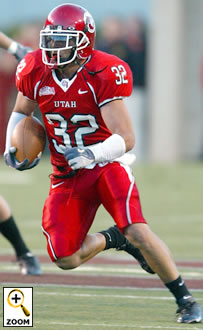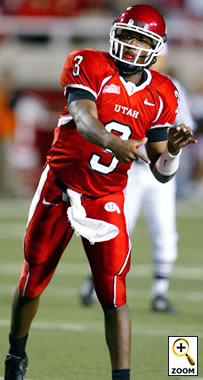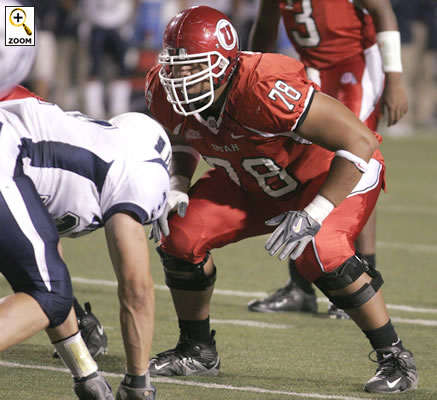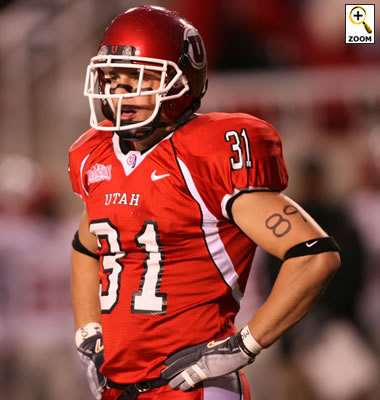 |
| DB
Eric Weddle |
|
| |
| 2005
Statistics |
Coach:
Kyle Whittingham
7-5, 1 year |
| 2005
Record: 7-5 |
|
| ARIZONA |
WON
27-24 |
| UTAH
STATE |
WON
31-7 |
| at
TCU |
LOST
20-23 (OT) |
| AIR
FORCE |
WON
38-35 |
| at
North Carolina |
LOST
17-31 |
| at
Colorado State |
LOST
17-21 |
| SAN
DIEGO STATE |
LOST
19-28 |
| at
UNLV |
WON
42-32 |
| WYOMING |
WON
43-13 |
| NEW
MEXICO |
LOST
27-31 |
| at
Brigham Young |
WON
41-34 (OT) |
EMERALD
BOWL |
| vs.
Georgia Tech |
WON
38-10 |
|
2005 Final Rankings
AP-UR, Coaches-UR, BCS-UR
|
| 2006
Outlook |
| The
first year under Kyle Whittingham
may have seemed to show drop off after
arguably the team’s best coach
ever left. But do not be deceived
by their 7-5 record from 2005 –
three of those losses were by four
points or less, including the three
point OT defeat against vaunted conference
foe TCU. This home game (10-5-06 versus
the Horned Frogs) will decide the
Mountain West winner, and Utah has
the wares to take the crown away from
them. Consistency on defense will
be their key to the title and a successful
season.
Coach
Kyle should be able to direct defensive
improvements from last year’s
disappointing 59th-ranking for total
D, for he was their coordinator under
Urban Meyer. Gary Anderson, the new
DC and assistant coach, is a defensive
line specialist, and with this area
(really the entire front seven) needing
to step up the most, the experience
and depth the Utes now field there
will do the trick. Well-sized and
just as mobile, their second year
under Anderson means Utah’s
sophisticated schemes should come
together.
Offensively,
this team is stacked in each of their
talent units, especially at QB and
WR, so only the line has to overcome
its issues inside (at center) to give
what is needed. How they decide between
dual-threats Ratliff and Johnson,
or if they rotate them (which is not
likely) is a great problem to have.
Either is good enough to finish in
the nation’s top 10 rankings
for QB efficiency, and therefore,
no one misses Alex Smith one bit.
Utah did have a scoring drop off in
the fourth quarter (only scored a
total of 44 combined points), and
defensively, they also let in the
most points in the closing stanza
(88), so if they can just get 60 minutes
worth of fury, this team should even
make a top 25 ranking by November
(at the latest).
UCLA
(away) is a challenge for their opener,
but this game and the one at the end
of September when Boise comes to town
are the only non-cons against whom
they can prove themselves. Both tilts
could go either way, which will dictate
whether UU makes a case for returning
to the BCS. Still, their ever-improving
conference features several teams
who, if Utah isn’t careful,
could again upset any title plight,
so we again point to consistency being
all they need to have to make the
most of this talented roster. Rice-Eccles
should be rocking with five of their
last eight there, which means there
is no excuse for Utah not placing
themselves back on the national map
of college football.
Projected
2006 record: 9-3
|
|
 |
| QB
Brian Johnson |
| UTAH
*POWER RATINGS |
| Offense |
Defense |
| QB
- 4.5 |
DL
- 3 |
| RB
- 3 |
LB
- 3 |
| WR
- 3.5 |
DB
- 3.5 |
| OL
- 3.5 |
.. |
|
| RETURNING
LEADERS |
| Passing:
Brian Johnson, 330-210-7, 2892 yds.,
18 TD
Rushing: Brian Johnson, 152
att., 478 yds., 8 TD
Receiving: Brian Hernandez,
39 rec., 709 yds., 3 TD
Scoring: Brian Johnson, 8 TD,
48 pts.
Punting: Louie Sakoda, 54 punts,
37.1 avg.
Kicking: none
Tackles: Casey Evans, 89 tot.,
43 solo
Sacks: Eric Weddle, 4 sacks
Interceptions: Casey Evans,
5 for 19 yds.
Kickoff Returns: Brent Casteel,
20 ret., 23.2 avg., 0 TD
Punt Returns: Eric Weddle,
24 ret., 6.4 avg., 0 TD
|
|
|
|
 |
UTAH
|
|
|
| OFFENSE
- 7 |
----RETURNING
STARTERS---- |
DEFENSE
- 9 |
|
| KEY
LOSSES |
| OFFENSE:
Quinton Ganther-RB, Travis LaTendresse-WR,
John Madsen-WR, Chad Jacobsen-TE, David
Dirkmaat-OG, Jesse Boone-C, Dan Beardall-K |
| DEFENSE:
Steve
Fifita-DT, Kite Afeaki-DL, Spencer Toone-LB,
Grady Marshall-LB, Eugene Oates-CB,
Tim Harris-SS |
|
|
| 2006
OFFENSE |
| Quarterback
There
is just too much talent here for one team
to field. Brian Johnson, who looks and runs
like No.1 NFL pick Alex Smith, was stellar
as a freshman. The all-MWC second teamer
has picked up the Ute’s spread attack
and applied his talents accordingly. Johnson
finished second in team rushing, but more
importantly, he finished ranked 11th in
the nation for pass efficiency. The loss
to New Mexico saw Johnson tear his ACL,
and he is still recovering throughout the
summer. Then Brett Ratliff stepped in the
last two games and soared. The JUCO-transfer
is bigger than Johnson and had a better
efficiency rating in winning both of his
starts – the 38-10 drubbing of Georgia
Tech has to mean he is currently their choice.
Then there is Tommy Grady, a transfer from
Oklahoma who is 6’7 and just as highly
anticipated. Grady is more pocket-oriented,
and his decision making skills make up for
his lack of running. The only problem is
how he transferred to play more, yet still
could get splinters from sitting on the
bench. Ratliff and Johnson fit into the
spread scheme best, but in their four-WR
sets, Grady would mean little change(s)
play-calling-wise (they would become less
“dimensional” if defenders knew
only RBs would be carrying the ball). With
so many qualified signal callers, what a
problem to have.
Running
Back
After
losing only the school’s eighth 1,000-yard
rusher (Ganther), coaches are concerned
about who will start, but we think the talent
pool is deep enough to float a number of
candidates. Darrell Mack has decent size
and can take the corner well – he
only lost three total yards on his 39 carries.
The sophomore has bulked up even more, so
he seems to be the tops (for now). Senior
Daryl Poston has received extra eligibility
due to perennial knee problems, and the
former-prep all-American has never really
made the impact promised. But since he started
at USC as a freshman (then transferred),
this speedster should finally hit. Then
there is Mr. Reliable, Mike Liti. Sized
well, he is the best blocker of these three
and has started (three times in 2003). Liti,
like the others, has soft hands –
none can be ignored as they go out for the
pass, or foes will pay. Wildcard Brent Casteel
got the rock 35 times, and lines up in the
backfield (H-Back) as often as he does at
WR for matchup problems galore (38”
vertical leap). Even more depth exists with
two quality incoming froshes, so it is just
a matter of time until the depth chart here
writes itself. Even after a starter is named,
RB-by-committee will assure that 60 minutes
of fresh legs give Utah another strong showing
in their one-back approach.
Receiver
There
are too many qualified bodies here, too
– the Utes will continue to spread
the ball evenly all over the field, and
foes therefore cannot stop them all. Brian
Hernandez is the lone senior starter in
this corps. This six-foot JUCO-transfer
gets YAC galore and should still be able
to win jump balls after recovering fully
from off-season ankle surgery (part of 4x400
state champs, 4x100 runner-up in prep).
Brent Casteel is officially part of the
starting group here and is just as good
after the catch, though he runs underneath
routes more often. Sophomore Marquis Wilson
(set state prep records for career TDs,
yards and average per catch; see Returns
section below for his sprint records) and
junior Derrick Richards, both similarly
sized (5’11, 175lbs.), round out those
who can stretch the field at will. Two other
6’3 guys, Freddie Brown and former-RB
Sean Smith, will see reps and cause their
own matchup problems as DBs concentrate
on the others. The list goes on and on –
the Utes are stacked like few other schools,
and no one in their conference will be able
to keep this area in check in their sophisticated
scheme(s).
Tight
End
The
buzz in Salt Lake is that offensive coordinator
Andy Ludwig will expand the roles here,
but the spring prospectus fails to list
the TE position as a starting capacity.
Hmm. Redshirts Lance Bordeleau and Chris
Joppru, along with fellow (incoming) frosh
Bubba Tuinei, will be the “hands-on”
guys, while a trio of former-DLmen will
be the “pushers”. Expect to
see a TE instead of an H-back about a third
to half of the time.
Offensive
Line
There
is good news and bad news. The good news
comes from the outside - it is covered as
two proven tackles return to start. Senior
Tavo Tupola will protect the QB’s
blindside well. The Kahuku(HI)-native is
super quick for his 300lbs., and will surely
again earn all-MWC status (second teamer
in ’05). Jason Boone is just as big
and fast, and is already a leader as he
played the most of any returning lineman.
The all-academic (MWC) junior will help
bring down the team’s total of 29
sacks allowed while plowing holes for the
RBs. Inside, soph Rob Conley rose from his
backup status to take the right guard spot
from now-LG Eric Pettit, who will have to
fend off a JUCO-transfer and a redshirt
freshman to keep his status. This competition
(depth) will bode well for the Utes with
whoever gets the final nod. But the bad
news is at center – no experience
here could unravel the unit’s cohesiveness.
Kyle Gunther seems to have the inside track,
but his only experience is on special teams,
and it was limited. If the injury bug hits,
most of the depth is relatively inexperienced
across the board. For big men, these guys
(most handpicked by ex-guru-HC Urban Meyer)
match up well against major-conferenced
opponents (as proven in the Emerald Bowl
versus Georgia Tech; UCLA is the ’06
opener), possess excellent footwork and
can do whatever is needed, as long as they
act as a unit in this complicated yet subtle
offense.
OFFENSIVE
BREAKDOWN
Last
year - the first year without offensive
architect Urban Meyer - was successful with
new OC Andy Ludwig running the show, and
things here should only improve. Utah finished
12th in both total offense and in passing,
a testimonial to how well Ludwig (also)
coaches these QBs and runs his own version
of the spread. Expect no drop off as there
is too much firepower here to say anything
less will happen in ’06. Many point
to the RBs and say little experience will
mean lesser results (32nd in ground production
last campaign), but the potential there
runs just as deep as any other talent area.
The QB problem is that three extremely qualified
guys have to realize one (or more) might
not see much action, if any, as the starter
is named and that person takes off like
Johnson did last year. Ratliff wouldn’t
have seen any snaps if Johnson’s knee
hadn’t blown, though Ratliff has the
inside track with his amazing showing and
Johnson still recovering through the summer,
but it is hard to call that race, too. The
line could be marginal if the outside shines
but the inside struggles as expected, but
the expansion of the TE spot and quality
blocking backs (Mack, Liti) should allow
those crazy schemes Utah runs to work, regardless.
Lots of reverses (super-quick Eric Weddle
sneaks a few of these) and fakes in their
three- and four-WR sets will continue to
keep pursuers flat-footed as option after
option can burn even BCS-aligned-quality
defenses. Ludwig’s second season here
will be even better and make many think
Meyer never left.
|
 |
| OT
Tavo Tupola
|
|
 |
| UTAH
2006 DEPTH CHART
Returning Starters/Key
Players |
| OFFENSE |
| QB |
Brian
Johnson-Jr (6-1, 199) |
Brett
Ratliff-Sr (6-4, 224) |
| RB |
Darrell
Mack-So (6-0, 216) |
Darryl
Poston-Sr (5-11, 197)
Mike Liti-Jr (5-10, 215) |
| WR |
Derrek
Richards-Jr (5-11, 175) |
Freddie
Brown-So (6-3, 217) |
| WR |
Brent
Casteel-So (5-10, 193) |
Sean
Smith-Fr (6-3, 207) |
| WR |
Marquis
Wilson-So (5-11, 173) |
Bradon
Godfrey-So (6-3, 198) |
| WR |
Brian
Hernandez-Sr (6-0, 175) |
Fano
Tagovailoa-Sr (6-1, 202) |
| OT |
Tavo
Tupola-Sr (6-3, 300) |
Terrence
Apted-So (6-3, 317) |
| OG |
Eric
Pettit-Sr (6-4, 306) |
Zane
Beadles-Fr (6-4, 308) |
| C |
Kyle
Gunther-Jr (6-4, 302) |
Jeremy
Inferrera-Jr (6-3, 292) |
| OG |
Robert
Conley-So (6-1, 311) |
Corey
Seiuli-So (6-3, 326) |
| OT |
Jason
Boone-Jr (6-4, 294) |
Dustin
Hensel-So (6-7, 322) |
| K |
Louie
Sakoda-So (5-10, 175) |
Ben
Vroman-So (5-11, 187) |
|
|
| 2006
DEFENSE |
| Defensive
Line
After
a marginal showing and losing their top
guy, the euphemism here is how the glass
can be seen half empty or half full depending
upon the breakdown. The Utes gave up four
per carry and earned a modest 29 sacks,
but they also have three returning starters
who are upperclassmen (two seniors and a
junior) who all show the promise/potential
to make this area improve. Martail Burnett
and Soli Lefiti have the ends covered. All-around
athlete and former-safety Burnett (Open
End) has the most overall ability (4.6 speed),
but Kaneohe(HI)-native Lefiti is the right
size to make the most of his chances. Depth
here is unproven but seems worthy. Paul
Soliai, a former OLman (and JUCO all-American),
is sure to garner double-teams, which will
free his line-mates. Senior NT Kelly Talavou
also has the size-footwork combo to make
his inside presence felt, and he can even
cover in the flat. All of these starters
are well-rounded (not being sarcastic, though
they are big individually) and just need
to stay fresh for 60 minutes to make this
the strength of the defense. The reserves
coming in at tackle/guard in this year’s
recruiting class just need time and then
they will guarantee that Utah’s entire
line is (at least) a notch better.
Linebacker
Joe
Jiannoni leads a pack of junior starters
who are the biggest question mark on this
side of the ball. Jiannoni really made an
impact at MLB last campaign, but becomes
the “rover” and has huge shoes
to fill (departed Spencer Toone led MWC
– and the team - in tackles). He shouldn’t
disappoint, but filling Toone’s spot
in the middle is where doubts are raised.
Loma Olevao and JUCO-transfer Chet Blasucci
are both big enough to plug up running lanes,
but former-WR/TE Olevao and outside candidate
RS-frosh J.J. Williams have the speed needed
for the best quality in (underneath) coverage.
The “stud” LB position is well-stocked
with starter Kyle Brady, Utah’s prep
“Mr. Football (2002), and Malakai
Mokofisi bringing the heat. Like the line
in front of them, this corps has to take
it up to the next level so the defense can
be consistent, which was a big problem last
year. As this group goes, so goes the whole
D, and therefore the whole team.
Defensive
Back
The
conference’s Defensive Player of the
Year returns, and Eric Weddle will again
prove why he is the best player Utah has
at any position. Weddle moved up into his
current cover spot by demand, and still
can produce across-the-board stats as he
cancels out whoever he is on that day (Emerald
Bowl Defensive MVP as he smothered all-American
Calvin Johnson). He is on our second team
all-American squad, so you know this two-way
player brings the wood early and often (three
forced fumbles) – his number is called
by announcers seemingly all day. Complimenting
him is Shaun Harper, who is a bit slow (4.52
in the 40) and small (5’9), but seems
to also get the job done. Senior strong
safety Casey Evans was second team all-conference
and the six-footer can close the gap in
coverage deceptively well (five INTs led
team). Free safety Steve Tate brings the
most experience (transferred from Utah State
after 2001 season). This local product and
former-walk-on will provide as much leadership
as Weddle, which will allow this entire
unit to improve on its 47th ranking in efficiency.
Quality depth means coverage against those
MWC pass-happy foes can keep up, too. The
potential here could make them a top 10
unit, and the Bruins will let us know right
away whether they are capable of such or
not.
DEFENSIVE
BREAKDOWN
This
is an area that cost the Utes some losses
in ’05, but should improve within
all areas. The line, through hard lessons,
learned much, and it is now mostly seniors.
The size and mobility they possess means
they just have to come together as a unit
to be all they should. The LBs are supposed
to be the question mark, but experience
here, too, will overcome their realignment.
The front seven’s ability to stop
the run and pressure opposing QBs will be
the ripple that bolsters the rest of the
defense’s dimensions, for the secondary
is stacked with Eric Weddle and two safeties,
any of whom can do it all. With head coach
Whittingham the team’s former defensive
coordinator, there are no excuses for this
D not to dominate in their conference (second
last year in total yards and scoring allowed),
and since we know the offense will click,
the team’s destiny rests on whichever
eleven they are fielding. Utah cannot again
allow the fourth quarter to be one where
opponents score the most. Similarly, they
cannot force third downs only to allow a
40% success rate. If we see the same marginal
slipping this campaign, you can bet there
will be a price to pay in the loss column.
|
 |
| DB
Casey Evans
|
|
 |
| UTAH
2006 DEPTH CHART
Returning Starters/Key
Players |
| DEFENSE |
| DE |
Martail
Burnett-Jr (6-3, 248) |
Alex
Puccinelli-Jr (6-1, 236) |
| DT |
Kelly
Talavou-Sr (6-2, 307) |
Bryce
Scanlon-So (6-2, 274) |
| NG |
Paul
Soliai-Sr (6-4, 318) |
Kenape
Eliapo-Fr (6-0, 290) |
| DE |
Soli
Lefiti-Sr (6-4, 265) |
Casey
Sutera-Jr (6-3, 262) |
| SLB |
Kyle
Brady-Jr (6-1, 232) |
Malakai
Mokofisi-Jr (6-2, 228) |
| MLB |
Loma
Olevao-Jr (6-1, 232) |
Chet
Blasucci-Jr (6-1, 241) |
| ROV |
Joe
Jiannoni-Jr (6-1, 230) |
Taylor
Miller-Jr (6-1, 222) |
| CB |
Eric
Weddle-Sr (6-0, 200) |
Ryan
Smith-Jr (5-10, 165) |
| CB |
Shaun
Harper-Sr (5-9, 180) |
Brice
McCain-So (5-9, 178) |
| SS |
Casey
Evans-Sr (6-0, 202) |
Kyler
Rushton-Fr (6-0, 203) |
| FS |
Steve
Tate-Jr (5-11, 197) |
Joe
Giuliani-Fr (6-1, 201) |
| P |
Louie
Sakoda-So (5-10, 175) |
.. |
|
|
|
|
| 2006
SPECIAL TEAMS |
| Kicker/Punter
Louie
Sakoda will step in to now handle placekicking
needs along with his already-strong kickoff ability.
The sophomore has a big leg, but his punting duties
will be relieved by Brent Rawlings. Sakoda has
never hit from past the 47 yard-line (prep longest),
so, until proven, Utah will not be able to achieve
three points until they get the ball inside the
30. With Weddle as their holder, expect the unexpected.
Sandy-native Rawlings will provide the same punting
quality - he can force fair-catches while dropping
it inside the 20 just as well as Sakoda could.
Net results should improve from the Ute’s
dismal 82nd ranking due to expansions in the team’s
defensive depth.
Return
Game
Weddle is another special teams weapon in UU’s
punt return arsenal. This was one area where Weddle
wasn’t all that, failing to average even
seven yards per return, but his speed and vision
of the whole field should come to bear eventually.
WR Marquis Wilson set the state prep record in
the 200 meters and won the 100 (2A) twice, but
this local sax player hasn’t proven much
with his chances (longest of his five PRs was
seven yards). Whichever proves the most in preseason
camp will surely bolster the Ute’s PRs.
Brent Casteel has been much more of a commodity
on KRs. Officially, these spots won’t be
decided until the fall, so it is obvious the coaching
staff will leave all options open until someone
steps up.
|
|